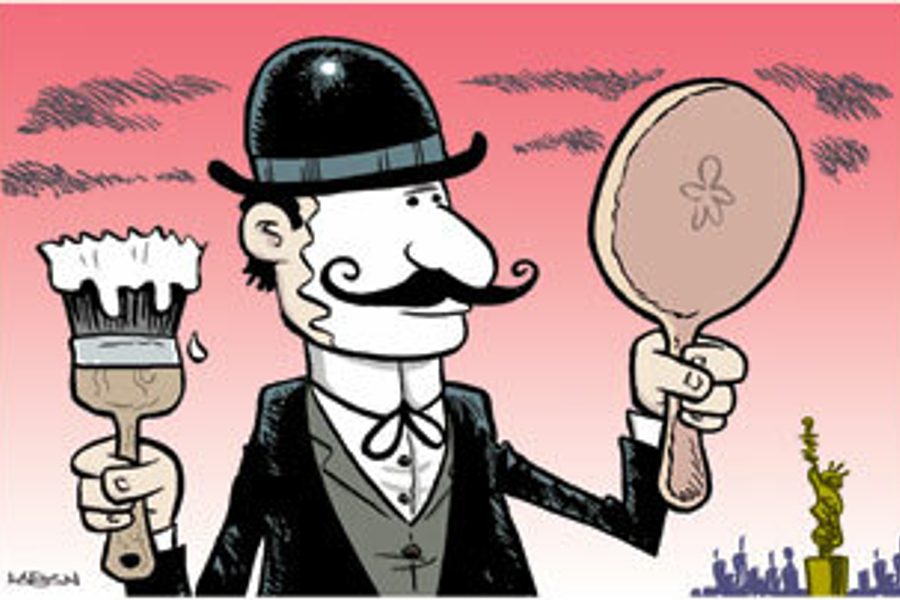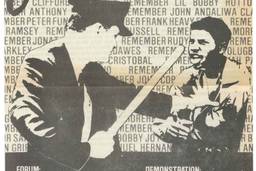
David Roediger – author of The Wages of Whiteness and Towards the Abolition of Whiteness–comes from Rush Limbaugh’s neck of the woods in downstate Illinois river country, but looks at his skin color quite differently.
In his 2002 book Colored White, the 52-year-old historian from the University of Illinois, Urbana-Champaign, notes that he hails from “that part of the Mississippi River which divides Missouri from Illinois … the lone portion of the Mississippi to divide slavery from freedom.”
“Geniuses such as Miles Davis, Chuck Berry, Scott Joplin, Katherine Dunham, Redd Foxx, Tina Turner, Quincy Troupe, Josephine Baker, Maya Angelou, Ntozake Shange and Mark Twain have drawn on experiences along the river to chart, move, explode and ignore the color line,” Roediger writes. And then there’s Rush Limbaugh from Cape Girardeau: “He is my age and, as I grew up in cities north and south of the Cape, his type was all too familiar to me.” Whenever he heard the radio pundit and television personality lauded as a media “genius,” writes Roediger, he recoiled. He says that such praise overlooks “how thoroughly [Limbaugh’s] ‘genius’ rests on an utterly unreflective and banal performance of whiteness.”
Transcending the commonplace “it takes one to know one,” Roediger has spent his career digging into the history of whiteness as an American cultural and political identity in opposition to blackness. His new book, Working Toward Whiteness: How America’s Immigrants Became White, unearths loaded phrases – from the 1820s epithet “red niggers” for Native Americans, to Hyde Park’s “racial frontier” marked by anti-black redlining in the 1920s – with a deconstructionist agenda.
“Whiteness is, among much else, a bad idea,” he writes. Surveying labor history – with scabs branded “white Sambos” and blacks called “smoked Irishmen” – Roediger imagines a post-racial political culture. “The whiteness of white workers, far from being natural and unchangeable, is highly conflicted, burdensome, and even inhuman,” he continues. “The idea that it is desirable or unavoidable to be white must be exploded.”
Working Toward Whiteness asks what happens when we think of assimilation as “whitening as well as Americanizing.” Government agencies and labor unions classified certain Americans as “new immigrants” and later as “white ethnics” – always to the detriment of African-Americans, he finds. As a cultural history of slurs, and metaphors, the book reports that advocates of a 10-hour workday in the 1830s called themselves ‘white niggers,’ though not in solidarity with real slaves.” One Congressional immigration hearing in 1912 included testimony calling Italians “full-blooded Caucasians” while the American Federation of Labor called them “white coolies.”
“Teaching Americanism, the labor movement also taught whiteness,” writes Roediger, who counters that legacy by giving workshops at union summer schools. Historically, gatekeepers expanded the rubric of “white” to include more and more off-the-boat Europeans – “our temporary Negroes” as one social scientist put it in 1937 – whose primary qualification was possessing a skin color lighter than America’s descendants of African slaves.
Roediger ponders the irony that in the 1920s, immigration quotas cut the influx of foreigners, while those already here were united into fronts of homeowners staking out “American” neighborhoods and “Yankeelands.” A number of Chicago-based homeowner associations promoted restrictive “covenant agreements.” Those who signed these legal promises to not sell residential property to blacks created a “marvelous delicately woven chain of armor,” thumped the Hyde Park Herald.
Even street gangs of the time reflected the trend to embrace ethnics and banish blacks. During Chicago’s 1919 race riot, an Irish gang tried to enlist allies among eastern European immigrants living near the stockyards by scapegoating blacks. Under cover of night, in the early hours of August 2, members of the gang put on blackface and torched houses, leaving 948 Lithuanians and Poles homeless, yet failing to incite anti-black retaliation. Polish and Jewish newspapers took neither side since their readers were not yet lifetime subscribers to whiteness.
Roediger himself was not born with a nuanced understanding of race. Growing up in all-white Columbia, Illinois, he picked up such expressions as “Eeny, meany, miney, mo/Catch a nigger by the toe.” He never questioned the so-called Sundown law that kept blacks off the streets at night. But Roediger spent summers in his mother’s nearby “half-Black” hometown of Cairo, where he went to a black church for the sake of increasing his leisure time: “Its masses were the fastest, like only 25 minutes,” he recalls.
“Popular TV gave me a way to talk to my family about race,” says Roediger, a fan of “All in the Family.” He brought up race with his Aunt Anna Mae, the town phone operator, when watching “Sanford and Son.” She loved those shows but refused to work alongside blacks. Contradictions abounded in Columbia. “We all hated Blacks in the abstract, but our greatest heroes were the Black stars of the great St. Louis Cardinals baseball teams of the sixties,” Roedriger writes.
He remembers white friends embracing tunes by the Temptations and Jimi Hendrix while accessorizing with Confederate motifs. Rush Limbaugh was then spinning wax at KGMO in Cape Girardeau as “Rusty Sharpe.” “The most racist kids were the most attracted to Motown music – and certainly attracted to Tina Turner, who was living in East St. Louis then,” Roediger says.
Radicalized in high school, Roediger graduated from Northern Illinois University in 1975. He continued on to grad school at Northwestern, where he wrote his thesis on the fight for an eight-hour workday. After a year at Yale editing the Frederick Douglass papers, he returned to Northwestern in 1980 to teach labor history. He picked ‘whiteness’ as a specialty after Reagan was elected and commentators christened new electorates – the “Reagan Democrats” and “white workers.”
“Historically, I wondered what’s the root of this idea of thinking of yourself as a ‘white worker,’” says Roediger. “The only intellectuals writing books for whom whiteness was a problem were intellectuals of color. Whiteness really wasn’t a problem for white people. Most scholars would say ‘well, they are white so of course they think they’re white workers.’”
That truism might do for Limbaugh’s demographic, but not for Roediger’s cohort of labor historians. White workers are not born that way. Nor are scholars of whiteness.






